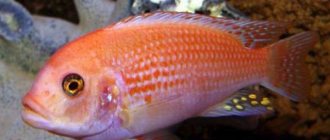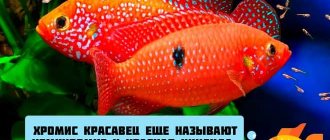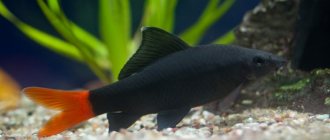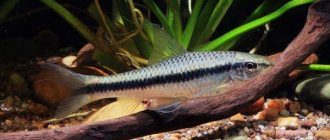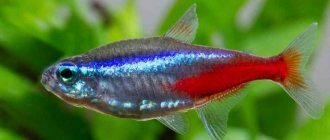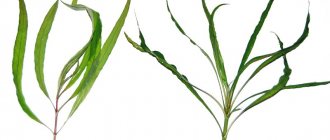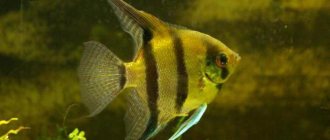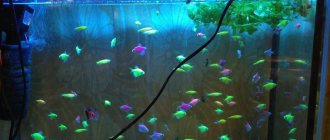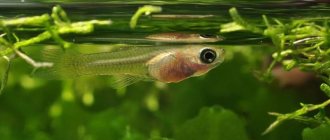Red aquarium zebra
The body shape of this aquarium fish bears a significant resemblance to a torpedo. Coloration varies from red-blue to light red-orange. The maximum body length reaches eighty millimeters. The red zebra is not an aggressive species, but it is not friendly towards its neighbors in the aquarium. At the same time, red pseudotropheus is unpretentious in care and can easily adapt to a variety of conditions. The lifespan of the red zebra fish is approximately ten years.
Compatibility with other fish
To distribute the aggression of pseudotropheus, experienced aquarists advise keeping them in densely populated aquariums. These can be species or mixed aquariums. At the same time, the neighborhood should be selected very carefully, even for the most peaceful red individuals. Peace-loving, calm fish will suffer with such neighbors. The main recommendation is to keep them together with Malawian cichlids. It is better if the fish are different in size and have different colors from pseudotropheus.
Zebra aquarium fish and its contents
Aquarium volume
It is advisable to keep zebra fish in a large community aquarium together with Malawian cichlids. The volume of an aquarium designed for one male and several females should be at least one hundred and fifty liters. Algae with hard leaves and strong roots should be planted in the aquarium and caves should be arranged in it.
Decorative elements
Various pebbles, corals, and driftwood can be used as decorative elements. Fluorescent lamps are most suitable for lighting.
Water temperature
The optimal water temperature in an aquarium is between 24 and 28 degrees Celsius. Every week you need to replace a third of the water. Aeration and powerful filtration must be provided.
Feed
You need to feed pseudotropheus with plant foods: nettles, lettuce, cabbage, sweet peppers. In addition, this fish willingly eats black bread, cyclops, coretra and daphnia, which provide them with a bright color. From time to time, pseudotropheus can be given dry and frozen food.
If the owner of aquarium zebras wants to increase their number, then it is necessary to take timely care to ensure suitable conditions for this.
Reproduction
Pseudotropheus are capable of reproducing from the age of eight to twelve months. They require a calm environment to spawn. You can speed up the reproduction process with the help of enhanced nutrition: for this you need to feed the fish a little more often than usual. The female lays about twenty-five to thirty eggs, which she then hides in her mouth. After this, the male fertilizes the eggs, and the female swims with them until the fry appear. If comfortable living conditions are provided and the correct temperature conditions are observed, the fry appear in an artificial reservoir two to three weeks after spawning. Their size is five to six millimeters. The fry are quite nimble and skillfully hide at the bottom among the stones. Adult pseudotropheus do not show much interest in hunting, so usually the fry grow up safely in a community aquarium. The fry do not need separate feeding; they independently find food for themselves in the same places as adults.
Pseudotropheus is widely popular due to its striking beauty and ease of maintenance. By following simple rules for caring for zebra fish, any aquarist has the opportunity to enjoy the sight of these bright and active inhabitants of the underwater world.
Other interesting articles
- Comet fish aquarium One of the most beautiful inhabitants of the aquarium is the comet fish, which is also known as the “golden…
- Aquarium telescope fish A distinctive feature of the aquarium telescope fish is its large, convex eyes protruding on the sides. It is because of this...
- Shark aquarium fish Please note that these fish are not real sharks and only look like them in appearance. Among the aquariums…
Maintenance and care
Pseudotropheus zebra is considered a fairly unpretentious aquarium fish that does not impose high demands on living conditions. Many connoisseurs of aquatic organisms are attracted to this species, like other cichlids, primarily by its behavioral features.
- However, the aggressiveness of individuals and the desire to establish a hierarchy with a clear division of territory forces aquarists to house fish in a school with 1 male and 3-4 females. This allows you to avoid manifestations of species aggression, which would necessarily arise between several males. Especially during the spawning season.
- For one flock you will need an aquarium with a volume of 150 liters or more. The container should be rectangular in shape. It is desirable that the length of one of the walls be from 1.2 meters. It would be a good idea to cover the aquarium with a lid. Otherwise, fairly active fish may jump out of the vessel and be injured or die.
Water parameters for ideal maintenance
Experts recommend maintaining the following hydrochemical parameters:
- temperature - 24-28ºС;
- hardness - 5-20º;
- acid-base balance - 7.2-8.5.
In an aquarium, water filtration and aeration are required. It is also necessary to replace 1/3 of the volume of aquarium liquid every week.
Requirements for light and design of the aquarium
Comprehensive lighting is recommended. Incandescent lamps and fluorescent lamps can be used as light sources. This will allow you to place various aquatic plants in the aquarium, which are recommended to be planted in large quantities.
Since pseudotropheus zebra feeds on both protein and plant foods, it is necessary to select strong flora. Plants should have dense leaves and a strong root system. Otherwise, the cichlids will gnaw on their “green neighbors.”
When decorating an aquarium, you can recreate the natural habitat of Pseudotropheus zebra. It is necessary to use medium and large stones, install more shelters and caves, and put down driftwood.
What to feed pseudotropheus zebra
In its natural habitat, zebra pseudotropheus feeds on plankton and aquatic plants.
When kept in an aquarium, you can give both live and dry food. The following are allowed as protein foods:
- Daphnia;
- cyclops;
- coretra.
Plant ingredients should make up at least 70% of the total diet. What can you give to cichlids:
- cabbage;
- salad;
- nettle
Among specialized feeds, you should pay attention to the following products:
- Tetra Malawi Flakes is a food with a high content of plant ingredients. It contains a special mixture of algae. Designed for feeding cichlids, in particular pseudotropheus.
- Tetra Cichlid Color is a pellet food suitable for owners of red, yellow or bright orange fish. Allows you to maintain the rich color of the scales of aquatic organisms.
- Sera Granured is a protein food for cichlids that maintains the brightness of the scales of red fish.
- Sera Granugreen is a specialized food for herbivorous cichlids.
- JBL NovoMalawi, JBL NovoRift are the main foods intended for herbivorous cichlids common in Lakes Tanganyika and Malawi. The first is made in the form of flakes, the second in the form of sticks.
- JBL NovoTanganjika is a staple food based on fish and plankton. Designed for cichlids from lakes Tanganyika and Malawi.
When feeding Pseudotropheus zebra, do not give too much food. Overeating has a negative impact on the health of fish. It is advisable to hold a fasting day for pets once a week.
Description
Adults reach a length of about 13 cm. The body color is pale blue with barely noticeable dark vertical stripes. Sexual dimorphism is weakly expressed. Unlike females, males are somewhat larger, have an enlarged frontal part on the head and have a characteristic pattern on the anal fin in the form of yellow specks.
Externally, it is very similar to one of the color forms of the Red Zebra Cichlid. Despite the name, some varieties are blue in color and are almost identical to the Blue Zebra.
Other shapes and similar species
The main variability in African cichlids from Lake Malawi is observed in the color of individuals. The most popular among aquarists are fish of four color forms.
- White. Albinos, bred artificially. Fish with such colors are not found in their natural habitat. The snow-white fins and scales have a slight blue tint upon closer inspection.
- Blue. The most famous color variation is Pseudotropheus zebra. The body and fins of the fish are colored light blue. There are vertical stripes of a darker shade on the body. Old males lose the brightness of their scales over time.
- Red. This color is characteristic only of females, while males are colored blue. There are from 7 to 9 vertical stripes on the body. On the anal fin you can often see yellow spots with dark edging.
- Yellow-orange. It has a uniform color of scales and dark spots on the anal fins. In an aquarium it attracts attention with its brightness.
Pseudotropheus zebra - red (Pseudotropheus zebra)
Pseudotropheus zebra - red (Pseudotropheus zebra)
Size
S - up to 4 cm, M - up to 6 cm, L - up to 8 cm, XL - up to 10 cm.
Habitat
Lake Malawi - coastal rocks.
Description
One of the most famous and popular Malawian cichlids from the mbuna group, with more than 50 color variations. The most popular among aquarists is the double red form - a yellow-pink male and a bright orange female. The red forms of zebras are brightly colored from early childhood. All forms of zebras interbreed easily.
Keeping in an aquarium
Conditions of detention are common for the group. The brightness of the red color directly depends on the amount of carotenoids in the feed. Good results when maximum brightness is achieved are carrots, paprika and various crustaceans included in the feed mixture. To keep zebra pseudotropheus, you need an aquarium with a landscape of stones reaching the surface of the water (with the upper part overgrown with algae), crevices and caves. You can plant plants with hard leaves and a strong root system, and strengthen ferns on stones. It is better to use a combination of lighting in the aquarium: incandescent lamps and fluorescent lamps. Water parameters for optimal maintenance of pseudotropheus: water hardness 4-20°, pH 7.2-8.5, temperature 24-28°C. Aeration, powerful filtration and weekly changes of up to 20-30% of the water volume are desirable.
Compatibility
The species is distinguished by its peace-loving nature and can be kept in the company of other peaceful cichlids.
Breeding
Pseudotropheus zebra reaches sexual maturity at the age of 8-12 months. Zebra pseudotropheus spawning can take place in a community aquarium. Drainage tubes with a large hole are placed at the bottom so that they are clearly visible from any angle. The female lays 40-100 eggs with a diameter of 4 mm. For 17-21 days, the female incubates the eggs in her mouth (artificial incubation of the eggs is possible).
The starting food is small plankton. Up to 6-7 months, the fry have a uniform grayish-brown color.
Feeding
Fish should not be overfed, because... the species is prone to overeating and obesity. About 70% of the diet should consist of plant components: lettuce, spinach, dandelion, plantain, scalded nettle leaves, rolled oats, rolls of white and black bread (as a top dressing). As for animal feed, any standard food is suitable: coretra, bloodworms, daphnia, seafood, beef liver, etc. Fish are omnivores, which allows you to experiment with the composition of your diet.
Habitat
Wild Zebras live exclusively in Lake Malawi in Africa. They live at various depths along rocky shores, reefs, and islands. They belong to the Mbuna group, which translated from the local dialect means “dwellers of the rocks.”
Requirements and conditions:
- Aquarium volume - from 200 liters.
- Temperature - 23–28°C
- pH value – 7.2–8.8
- Water hardness - medium hard and hard (10–25 dH)
- Substrate type - coarse sand and stones/boulders
- Lighting - moderate
- Water movement - moderate
Fish parameters:
- Size - 5–6 cm.
- Diet: plant-based with occasional meat supplements
